 设为首页
设为首页
 加入收藏
加入收藏
Climbing history of Mount Everest
The discovery of the world's highest mountain
The detailed survey of the summits of the Himayalas by British surveyors between 1847 and 1854 was not an easy task, since Nepal was closed to foreigners. The high mountains were measured from distances of sometimes more than 200 km. In the year 1856, as one of the result it was clear that Peak XV, with a height of 29002 feet, had to be the world's highest mountain. Unaware of local names, Surveyor General Andrew Waugh proposed to name the mountain after his predecessor, George Everest. This name prevailed until today, although the mountain has two local names - Chomolungma in Tibetan, Sagarmatha in Nepali.
Taking the technical means of the 19th century into consideration, the precision of the surveys of that time is astonishing - the altitude computed in 1856 differs from the latest survey (8850 m) only by 10 meters. Until the middle of the 30s, time and again there are rumours about mountains higher than Everest. Candidates were Nyenchentangla, which later turned out to be only 7162 m high, and also Minya Konka (7556 m). The latter enjoyed a visit by us last year.
1921-1924
Around the turn of the century, the first good photographs of Mount Everest
are made. It was the twenties when the first expedition reached the area.
The reconnaissance of 1921 can find a feasible way to the north ridge and
can clarify the topography which was very unclear till then. The British expedition
of 1922 is thwarted by bad weather but reaches an altitude of 27300 feet (8320
m).
During the legendary expedition of 1924, Norton and Somervell reach an altitude
of 8565 m without additional oxygen. Mallory and Irvine, who are using bottled
oxygen, disappear five days later during their summit attempt. Till today
it is not known if they have reached the summit.
1933
More British expeditions are visiting the mountain in the thirties. The extraordinarily bad weather doesn't allow a summit success in 1933. Frank Smythe reaches the same altitude as Norton in 1924.
1951-1959
After world war II, Tibet was no more accessible for western visitors. After a - once again British - reconnaissance expedition in 1951, a Swiss expedition takes the route through the Khumbu icefall but must turn back only 300 meters below the summit. The British expedition of 1953 finally is successful - Edmund Hillary and Tenzing Norgay reach the summit on May 29, 1953. Three years later, a Swiss expedition carries out the second summit climb.
1960-
In 1960, a gigantic Chinese expedition with more than 200 members tries to reach the summit on the north route. Three participants reach the summit in the middle of the night. Due to the lack of evidence and the very ideologically formulated reports there was a long dispute about this climb, but meanwhile it is generally accepted.
In 1963, the Americans Unsoeld and Hornbein master the third route, the west ridge. This expedition also makes the first traverse of the summit (from the west ridge to the south ridge).
In 1975 there is another Chinese expedition on the north side. They erect the famous tripod on the summit which serves as a survey mark. The Tibetan Phantog is the second woman on the summit, only eleven days after Japanese Junko Tabei who ascended on the south route. The Chinese expedition of 1975 also puts up the ladder at the second step.
In 1978, Reinhold Messner and Peter Habeler can prove that the summit can be reached without artificial oxygen. By far a less known fact is that already in fall of that year, Hans Engel reaches the summit as the first German without additional oxygen.
In 1983, an American expedition climbs the huge east face.
Since then the mountain was climbed on more than a dozen different routes. The numbers of climbers on these - often exotic, very difficult and/or dangerous - routes, however, are marginal compared to the normal routes.
During the 90s, a kind of mass tourism developped on the two main routes. In order to contrast with the masses, many believed (and believe) that they have to set up a record. There were ski and snowboard descents from the summit, and many more things. The youngest climber gets younger and younger, and the oldest climber gets older and older. It seemed that everybody - just by spending enough money - could reach the summit. The sufficient criterion seemed to be having climbed a 4000 m peak before. If not, having seen a 5000 m peak might qualify as well... These climbs have no alpinistic motivation - for many, Mount Everest has degraded to a tool to compete in vanity. A pity, since the unique height gives an interesting touch. It should be enough if only those who are interested in the mountain would go there.
Already before the disaster of 1996 it was clear that the idea of a summit success for every paying client was only an illusion. No 8000 m peak can be climbed without any risk. Mountaineering experience reduces the risk, but it can never be made zero.
Probably it is only a matter of time until the first climber will summit with water wings or something comparably stupid. Just because nobody before did it. But, this will not be one of us; we want - with a bit of luck - to climb this mountain in the fairest possible way. What fairness is, what might me unnecessary and what really is important, is everybody's own decision in the end.
开辟珠穆朗玛峰各路线的人
珠穆朗玛峰在中国和尼泊尔两国的边境分水岭上,它一直是在全世界登山家向往攀登的顶峰。
半个多世纪以来,各国主要登山勇士沿着珠峰的山脊山壁,打开了8条通向顶峰的道路。
1953年5月29日,英国的希拉里和尼泊尔的诺尔盖在人类登山史上第一次征服了这座神秘的山峰。他们走的是东南山山脊路线。
1960年5月25日,中国登山队的王富洲等3人从东北山脊线路登上珠峰。
1963年5月22日,美国登山队的霍恩拜因登上顶峰,开创了一条从西山脊转北壁的路线。
1995年9月24日,英国登山队从西南壁登上峰顶。
1974年5月18日,南斯拉夫登山队从西山脊路线攀登成功。
1980年5月10日,日本登山队沿北壁直上登上珠峰。
1980年5月19日,波兰登山队探出了南柱状山脊路线,到达顶峰。
1980年8月20日,意大利的莱·梅斯纳从“北坳”沿东北山脊再转向北壁,然后从正北脊上顶峰。他在最后冲刺时无助手,无氧气,并开创了独自一人登上珠峰的记录。
Earth
The Earth is the planet we live on.It formed about 4.5 billion years ago from a cloud of dust,rock and gas.Over millions of years since then,volcanoes,earthquakes,wind and rain have changed its surface.Scientists think the Earth is the only planet in the Solar System where plants and animals can live.
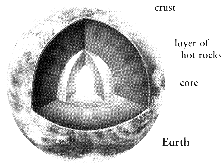
The Earth is a giant ball of rock. Beneath the surface,this rock is so hot that some of it is melted and runny.Around the outside,the rock forms a hard crust.
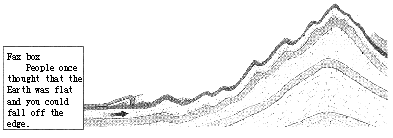
The Earth's crust is made up of enormous sections called plates.These move very, very slowly.Sometimes they push against each other and crumple.When this happens,mountains form.
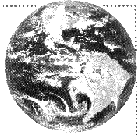
Two-thirds of the Earth is covered in salty sea water.Around the Earth is a blanket of air,called the atmosphere.
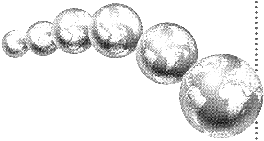
Millions of years ago,the land on Earth was joined together in one huge continent. Gradually,it split up and formed the continents we have today.These are still moving slowly.Millions of years from now,the surface of the Earth will look very different from the way it does today.
THE WORLD’S ENVIRONMENTS
Where people live and the way in which they live depend on the different environments that make up our world.These environments,or surroundings,include evergreen forests(where the trees keep their leaves all year round),deciduous forests(where the trees drop their leaves in the autumn),rainforests,grasslands,mountains and deserts.It is cold and icy in the regions near the North and South Poles.
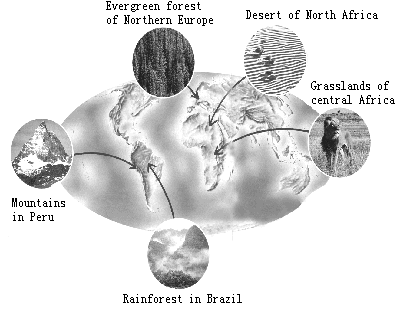
Fact file:
The world 's land is divided into seven continents: Africa, Antarctica, Asia, Australasia, Europe, North America and South America.
The area around the North Pole is called the Arctic; it is covered by the Arctic Ocean , which is frozen at the surface.
The area around the South Pole is the continent of Antarctica, where the land is permanently covered by ice and snow.
Deserts cover about one seventh of the Earth's surface.
Quiz:
1. Which is the largest continent?
2. Which type of forest do pine trees grow in?
3. Which continent has no people living on it permanently?
4. Is an apple tree deciduous or evergreen?
5. Which river runs through the world's biggest rainforest?
6. Which is the smallest continent?

Key:
The World's Environments:
1.Aisa.2.Evergreen 3.Antarctica.4.Deciduous.5.Amazon. 6.Australasia.
Find their way home:1.c 2.d 3.a B.is the odd one out!
Saying Good-bye to Cambridge Again再别康桥
徐志摩
Very quietly I take my leave
As quietly as I came here;
Quietly I wave good-bye
To the rosy clouds in the western sky.
The golden willows by the riverside
Are young brides in the setting sun;
Their reflections on the shimmering waves
Always linger in the depth of my heart.
The floating heart growing in the sludge
Sways leisurely under the water;
In the gentle waves of Cambridge
I would be a water plant!
That pool under the shade of elm trees
Holds not water but the rainbow from the sky;
Shattered to pieces among the duckweeds
Is the sediment of a rainbow-like dream?
To seek a dream? Just to pole a boat upstream
To where the green grass is more verdant;
Or to have the boat fully loaded with starlight
And sing aloud in the splendour of starlight.
But I cannot sing aloud
Quietness is my farewell music;
Even summer insects keep silence for me
Silent is Cambridge tonight!
Very quietly I take my leave
As quietly as I came here;
Gently I flick my sleeves
Not even a wisp of cloud will I bring away轻轻的我走了,
正如我轻轻的来;
我轻轻的招手,
作别西天的云彩。
那河畔的金柳
是夕阳中的新娘
波光里的艳影,
在我的心头荡漾。
软泥上的青荇,
油油的在水底招摇;
在康河的柔波里,
我甘心做一条水草
那树荫下的一潭,
不是清泉,是天上虹
揉碎在浮藻间,
沉淀着彩虹似的梦。
寻梦?撑一支长篙,
向青草更青处漫溯,
满载一船星辉,
在星辉斑斓里放歌
但我不能放歌,
悄悄是别离的笙箫;
夏虫也为我沉默,
沉默是今晚的康桥!
悄悄的我走了,
正如我悄悄的来;
我挥一挥衣袖,
不带走一片云彩。
IN FLANDERS FIELDS
John Mc Crae
In Flanders Fields the poppies blow
Between the crosses,row on row,
That mark our place;and in the sky
The larks,still bravely singing ,fly
Scarce heard amid the guns below.
We are the Dead.Short days ago.
We lived,felt dawn,saw sunset glow,
Loved,and were loved,and now we lie
In Flanders fields.
Take up our quarrel with the foe
To you from failing hands we throw
The torch,be yours to hold it high.
If ye break faith with us who die
We shall not sleep,though poppies grow
In Flanders fields
“In Flanders Fields”was first published in England's“Punch”magazine in December,1915. Within months,this poem came to symbolize the sacrifices of all who were fighting in the First World War.Today,the poem continues to be a part of Remembrance Day ceremonies in Canada and other countries.
The poem was written by a Canadian-John McCrae,a doctor and teacher,who served in both the South African War and the First World War.
Notes:
Flanders Field-name of a place in France;
poppies:small red flower;
lark(s):a type of bird;
scarce:very little,of hard to find;
amid:surrounded by eg.flowers,noise;
glow:bright light;
foe:an enemy;
sacrifice:something given eg.your life,pain;
ceremonies:a formal act eg.speech on National Day